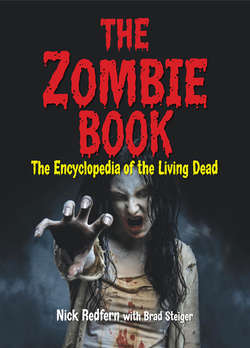Читать книгу The Zombie Book - Nick Redfern - Страница 41
На сайте Литреса книга снята с продажи.
Burial Traditions See also: Cemeteries and Tombs, Cremation, Funerals, Mummies, Mummification
ОглавлениеThe coffin has taken many shapes and forms in its evolution as a final resting place for the deceased. Many authorities attribute the presence of trees in the churchyard or cemetery to ancient notions concerning a hollowed out tree as a dwelling place for the spirits of the dead. In Babylonia, great boxes of clay were baked to form a kind of coffin in which the dead were buried.
The first actual coffins, as we know them today, probably originated in ancient Egypt where the people believed that the body of the deceased must be kept safe until a future time of resurrection. The Egyptian word for coffin is from Kas, which means to bury. Another form of the word became Kast, indicating the receptacle into which the body is placed, the coffin.
A Hindu ceremony is seen here in Kathmandu, Nepal, at the Pashupatinath Temple. The departed one’s body is cremated and the remains sent on their way down the holy Bagmati River.
In the Hindu faith, the deceased are given a ceremonial washing, then the body is wrapped in a burial cloth and placed on an open casket. If at all possible, within one day of death, the body is to be carried to a place of cremation by six male relatives. The body is placed on a stack of wood and covered with flowers. Melted butter is poured over the body to help it to burn, and the eldest son or nearest male relative of the deceased lights the funeral pyre.
Traditionally, the cremation takes place outdoors and the ashes are collected and scattered in the waters of a holy river, such as the Ganges. In other countries, Hindu dead are taken to a crematorium. Followers of the Hindu religion believe that the soul, the Atman of each individual, is reborn many times in a cycle of spiritual evolution before it can become one with God.
Those who follow the path of Judaism bury their dead in a plain coffin after the body has been washed and dressed. If possible, the funeral takes place on the day after the death has occurred. The coffin containing the deceased is taken first to the synagogue and then to the place of burial.
At the gravesite, the rabbi says a few words of remembrance about the deceased, and the coffin is placed in the grave. The closest male relative of the deceased says a prayer called the Kaddish to help the soul travel to the Olam Haba, the world to come, and the family of the dead person fills in the grave with earth.
Muslims prefer not to use coffins for their dead unless they are residing in a country that requires such containment for the deceased. If it is possible to do so, the dead are buried on the day following their death. The deceased is washed, perfumed, and wrapped in three cotton burial cloths.
Those who follow the religion of Islam believe that the soul of the deceased is guarded by the angel of death in a place called Barzakh until the Day of Judgment. If at all possible, friends and relatives gather around a dying person and read verses from the Quran. With his or her last breath, the dying person always tries to say the Shahadah: There is no God but Allah, and Muhammad is his messenger.
Large graves and headstones are not permitted to mark a Muslim burial site, but the grave itself is to be raised above ground level. As the body is being taken to the burial ground, the Salatul Janazah, a prayer for the deceased is read. The body is buried facing Mecca, the sacred city toward which all Muslims turn when they pray.
